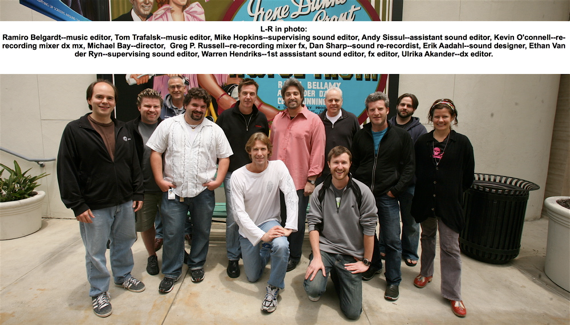Thanks to Re-recording mixer Kevin O’Connell for taking time out to do this brief Q and A!
Designing Sound: With this the second huge film you guys mixed this year(the first being Spiderman 3), how much adaptation is needed working with different directors and sound crews?
Kevin O’Connell: We had been in communication with Supervising sound editors Ethan Van Der Ryn and Mike Hopkins for many months prior to the mix strategizing and laying out a game plan for the mix. That communication helped us enormously. As far as working with different directors, having worked on numerous films for both Sam Raimi and Michael Bay really helped to get us where we needed be much faster then if we had not had that luxury.
DS: Did you guys do anything differently on this film you don’t normally do on others?
KO: Yes, we basically mixed the movie with mostly temp music tracks. The final music trickled in throughout the mix and was not all available until late during the final mix. At that point I basically had to re-mix the entire music stem on every reel and Greg (Russell) and the sound effects team had to re-shape a bit as well. Having had the benefit of mixing all of Michael Bays films helped enormously on Transformers. Michael is a guy who knows what he likes but more importantly knows what he does not like and communicates that very well.
DS: In films with such huge set pieces, how do you find a healthy balance between music and FX ?
KO: That is the challenge on all action adventure movies. That balance is the key to a great sound track. You can’t hear everything all of the time so knowing what to hear and when is really the cornerstone to any great mix.
DS: How were the transformer vocals handled on the dub stage? Is there much processing to their voices?
KO: We processed the entire conversational robot dialog during the dialog pre-dubs. We started by pitching down the autobots (good guys) approximately 1 semi-tone and the decepticons (bad guys) between 2 and 3 semi-tones. Then we fed the track into a small speaker in a chamber in the back of the stage and returned the output to the console and balanced it against the untreated track to add a bit of an edge. Then we took a feed to the lexicon 480 to add a bit of space and reverb to the track. We took another feed and sent it to the boom and adjusted each voice individually to maximize the effect. Then, we spread all of the voices into two, 5.1 predubs to maintain flexibility. As far as the non english speaking robots, they were cleverly processed by sound editorial prior to coming to the stage.
DS: On music passes, how much flexibility do you usually like to get coming from the editorial rig(s)?
KO: On these types of movies you have to have as many things separated as possible to maintain flexibility. The more the tracks are separated, the better.
DS: Do mixers usually go to test screenings to see how the temp dub plays in a “filled theater”?
KO: We try to go as often as possible but sometimes they are in different cities or even different states and we generally are in the middle of mixing for the final film and often don’t have the time to go. But when we are able to attend, it helps very much to see the film with an audience.
DS: Though chops and savvy are important. What other attributes must aspiring re-recording mixers possess to make it?
KO: In my opinion, the biggest attribute to being a successful mixer is in how you deal with people. You are often working with many high profile personalities at one time and that can be a bit tricky at times. Being as diplomatic as possible is a good start. I believe every one on the stage deserves to be treated with respect whether you are the assistant or the producer, everyone should be treated the same. Also, using every mixing experience to learn what works and what doesn’t work and applying that knowledge to future projects.
DS: Check back tomorrow for the conclusion of the Q and A’s with Sound Designer Erik Aadahl!
